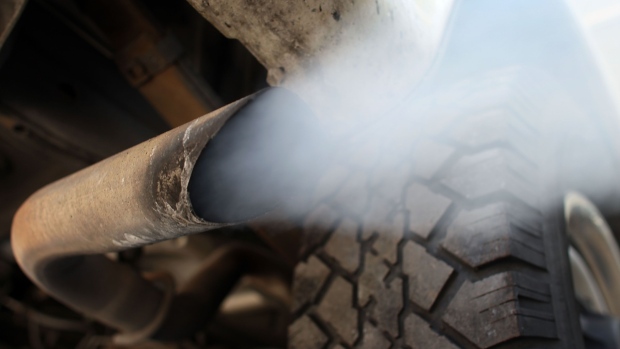Apr 6, 2023
Biden Is Set to Propose Toughest-Ever Rules on Car Pollution to Spur EVs
, Bloomberg News

(Bloomberg) -- The Biden administration is on track to propose the toughest-ever US curbs on car pollution, while stopping short of an electric-vehicle mandate or ban on gas-powered models.
The proposed standards on cars and light trucks, set to be announced Wednesday in Detroit, are expected to govern tailpipe emissions of carbon dioxide, smog-forming nitrogen oxide and other pollution from vehicles manufactured for model years 2027 through 2032. The plan was described by people briefed on elements of the proposal who asked not to be named because it isn’t yet public.
Major US automakers have pleaded for requirements extending just a few years, while EV manufacturers such as Tesla Inc. insist the administration should take advantage of new federal-government investments in charging and battery production to push for even stricter limits.
The plan is part of a multipronged Biden administration strategy to clamp down on planet-warming pollution from transportation and electricity, taking advantage of hundreds of billions of dollars of clean energy incentives under the Inflation Reduction Act. The Environmental Protection Agency, which is writing the new performance-based standards, also is set to propose new rules for greenhouse gas releases from heavy-duty trucks on Wednesday and power plants as soon as later this month.
Limits on car pollution are key to helping the US meet its Paris Agreement commitment to slash greenhouse gas emissions by at least 50% from 2005 levels by the end of the decade and fulfilling President Joe Biden’s ambition for at least half of all new vehicle sales to be electric models by 2030. While US automakers such as General Motors Co. and Ford Motor Co. have outlined bullish plans for EV sales, environmental advocates say aggressive tailpipe standards are necessary to prevent backsliding.
“There has to be continuous pressure for improvement,” said Dan Becker, director of the Center for Biological Diversity’s Safe Climate Transport Campaign.
The EPA declined to comment on the substance of the coming rules because they are currently under interagency review. In a statement, the agency said it’s developing new standards to build on Biden’s clean-energy progress and “support the transition to a zero-emissions transportation future, protecting people and the planet.”
The EPA’s auto standards are performance based — taking the form of maximum allowed emissions per mile — and do not prescribe specific technology for meeting the targets. However, electric vehicles are seen as a key way to fulfill the requirements.
Environmentalists, public-health and electric-vehicle advocates have lobbied the administration to ensure standards for model-year 2030 vehicles are 75% tougher than those governing 2021 models.
Strong standards are “incredibly important” to sending market signals to accelerate electric vehicle emissions and secure necessary emission reductions later on, said Britt Carmon, a senior advocate with the Natural Resources Defense Council.
The EPA is poised to reject some environmentalists’ requests to set standards through 2035, however. Automakers pushed for a shorter timetable, cautioning White House officials in a Feb. 14 meeting that the trajectory for EVs and emission reductions depends on factors outside their control, including investments in charging infrastructure and critical mineral production.
The shift will require a “massive, 100-year change to the US industrial base,” and the rule should be based on “a clear-eyed assessment of market readiness,” the Alliance for Automotive Innovation said Thursday.
The EPA proposal is set to also tighten limits on smog-forming vehicle pollution, potentially forcing automakers to adopt exhaust controls already used on cars sold in Europe, China and other markets.
It’s critical to stifle pollution from conventional gas-powered cars even as electric vehicles take off, said Paul Billings, national senior vice president of public policy for the American Lung Association. “We are going to have combustion vehicles being sold into the next decade, and we want to make sure that they are as clean as possible.”
(Updates with EPA comment in seventh paragraph.)
©2023 Bloomberg L.P.







